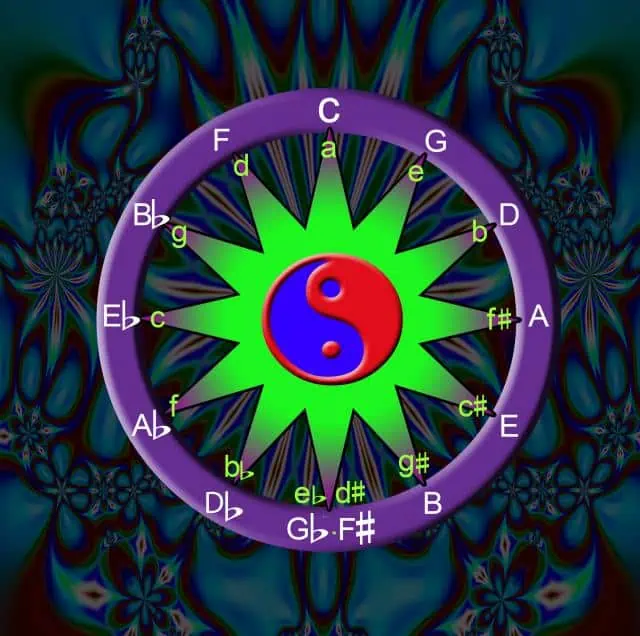Diminished chords in and of themselves can be difficult to listen to. That’s because diminished chords by themselves aren’t the most pleasant sounding. They sound dissonant and in my opinion, ugly. But when used correctly in conjunction with other chords, they make a chord progression more interesting. That’s because they add tension. They also sound awesome when used correctly.
Let’s look at where the C diminished chord occurs naturally in a key, and how to use it outside of a key to spice things up. Because yes, you can borrow chords from other keys to make a boring progression or song turn into something more exciting. Or poignant. Or whatever your creativity wills it to sound like.
Contents
How to Play the C Diminished Chord
If you simply want to know how to play the C diminished guitar chord, here you go. Below this section of diagrams is all the information on how to construct the C diminished chord and how to use it in your songs.
Cdim Version 1
This is a low voicing of the chord and will fit in with other open chords played in the top frets. As you’ll see in the fingering, it’s easier to play using your pinky, but you can use your ring finger too. If you prefer to strum the chord, mute the strings by angling your hand so that your fingers touch the open strings enough to mute them. That may be tough for the third string, but play around with the angle. Your thumb can mute string 6.
It’s easier to play this chord fingerstyle. You will find that with all the versions of this chord as none of the open strings can be used. Having said this, you can learn to skip the right strings if playing with a pick, all it takes is practice.
- Index finger: 2nd fret, string 1 (Gb)
- Middle finger: 3rd fret, string 5 (C)
- Pinky or ring finger: 4th fret, string 2 (Eb)
Cdim Version 2
If muting the strings in version 1 is proving a bit difficult, you can play this version. It’s easier to mute the two strings in this version and the chord will sound a little fuller if you want to strum it.
- Index finger: 2nd fret, string 1 (Gb)
- Middle finger: 3rd fret, string 5 (C)
- Ring finger: 4th fret, string 4 (Gb)
- Pinky finger: 4th fret, string 2 (Eb)
Cdim Version 3
Here’s another version in the top frets that’s easier when it comes to muting the strings. That said, it may take some practice to get your fingers to play this chord.
- Index finger: 1st fret, string 4 (Eb)
- Middle finger: 1st fret, string 2 (C)
- Ring finger: 2nd fret, string 1 (Gb)
- Pinky finger: 3rd fret, string 5 (C)
Cdim Version 4
Here’s another variation of Cdim in the first four frets.
- Index finger: 1st fret, string 4 (Eb)
- Middle finger: 2nd fret, string 1 (Gb)
- Ring finger: 3rd fret, string 5 (C)
- Pinky finger: 4th fret, string 2 (Eb)
Cdim Version 5
Here’s a nice easy version. It will be a bit higher pitched than the others considering it uses the first three strings, but it’s still a low voicing. Very nice for strumming or picking.
- Index finger: 2nd fret, string 1 (Gb)
- Middle or ring finger: 4th fret, string 2 (Eb)
- Ring finger: 5th fret, string 3 (C)
Cdim Version 6
This is a slightly higher voicing, but not by much. It’s a little easier to play because you can mute strings 1 and 6 without too much trouble. It’s also a slightly fuller chord for strumming.
- Index finger: 3rd fret, string 5 (C)
- Middle finger: 4th fret, string 4 (Gb)
- Ring finger: 4th fret, string 2 (Eb)
- Pinky finger: 5th fret, string 3 (C)
Cdim Version 7
This is like the above version, but without the fifth fret C. Use your thumb and angle your fingers to mute the open strings.
- Index finger: 3rd fret, string 5 (C)
- Middle or ring finger: 4th fret, string 4 (Gb)
- Ring finger: 4th fret, string 2 (Eb)
Cdim Version 8
This is slightly higher on the fretboard, but still fairly bassy.
- Index finger: 4th fret, string 4 (Gb)
- Middle or ring finger: 6th fret, string 5 (Eb)
- Ring finger or pinky: 8th fret, string 6 (C)
Cdim Version 9
This is a higher voicing that will go nicely over lower voicings of the chord if you’re playing with other guitarists.
- Index finger: 7th fret, string 2 (Gb)
- Middle finger: 8th fret, string 3 (Eb)
- Ring finger or pinky: 10th fret, string 4 (C)
Cdim Version 10
For a higher voicing with very little low end and less stretching, this version is great.
- Index finger: 7th fret, string 2 (Gb)
- Middle finger: 8th fret, string 3 (Eb)
- Ring finger: 8th fret, string 1 (C)
Cdim Version 11
This is the same as the previous version, just with a little low end for a slightly fuller tone.
- Index finger: 7th fret, string 2 (Gb)
- Middle finger: 8th fret, string 3 (Eb)
- Ring finger: 8th fret, string 1 (C)
- Pinky finger: 10th fret, string 4 (C)
Cdim Version 12
A voicing still in the middle of the fretboard but with much more low end.
- Index finger: 7th fret, string 2 (Gb)
- Middle finger: 8th fret, string 6 (C)
- Ring finger: 8th fret, string 3 (Eb)
Cdim Version 13
I recommend playing this by barring the strings as suggested below. If you struggle to barre the strings, just keep practicing. Your hand will build up strength if you do it regularly enough.
- Index finger: Barre 8th fret, strings 3-6 (C on string 6, Eb on string 3)
- Middle finger: 9th fret, string 5 (Gb)
- Ring finger: 10th fret, string 4 (C)
Or
- Index finger: 8th fret, string 6 (C)
- Middle finger: 9th fret, string 5 (Gb)
- Ring finger: 8th fret, string 3 (Eb)
- Pinky finger: 10th fret, string 4 (C)
Cdim Version 14
This is a much higher voicing and sounds lovely over lower voicings. It’s also really nice for picking.
- Index finger: 10th fret, string 4 (C)
- Middle finger: 11th fret, string 3 (Gb)
- Ring finger: 11th fret, string 1 (Eb)
Cdim Version 15
This is a high pitched, gently melancholic chord. Barring the 11th fret is the easiest way to play this chord.
- Index finger: Barre the 11th fret, strings 1-3 (Gb on string 3, Eb on string 1)
- Ring finger: 13th fret, string 2 (C)
Or
- Index finger: 11th fret, string 3 (Gb)
- Middle finger: 11th fret, string 1 (Eb)
- Ring finger or pinky: 13th fret, string 2 (C)
Cdim Version 16
This will give you a different tone to the one above with the Eb on the 4th string in the 13th fret as opposed to on the 1st string.
- Index finger: 11th fret, string 3 (Gb)
- Ring finger: 13th fret, string 4 (Eb)
- Pinky finger: 13th fret, string 2 (C)
Cdim Version 17
This is a combination of version 16 and 17. To make it easier, barre strings 1-4 in the 11th fret. Because you’ll be playing the Eb in the 13th fret on string 4, you don’t have to worry about playing the wrong note with your finger also barring string 4 in the 11th fret.
- Index finger: Barre the 11th fret, strings 1-3 (Gb on string 3, Eb on string 1)
- Ring finger: 13th fret, string 4 (Eb)
- Pinky finger: 13th fret, string 2 (C)
What is a Diminished Chord?
Basic chords are made up of three notes. The first, third, and fifth intervals or degrees of the scale. Depending on the key, these notes will be either sharp or flat. With diminished chords, both the third and fifth are flat.
C Diminished specifically is made up of C, Eb, and Gb.
To understand this, it’s easier to look at the C major chord which is C, E, G. You can now see that to make it a diminished chord, E and G have been flattened.
Read on below to find out how to work that out in the next section.
Where Do We Find C Diminished?
C diminished occurs naturally in the key of Bb minor. To understand this, you need to know what notes are in the key of Bb minor and the diatonic chords of this key too. The notes of course, form the scale. Diatonic chords are the kind of chords those notes form within the key, major, minor, augmented, and diminished.
Using the Circle of Fifths
An easy way to work out the notes of a key, is to look at the circle of fifths. Because we’re dealing with Bb, we’ll be looking at the flats (♭) in the key as opposed to sharps (♯).
As you can see, the key of Bb minor has five flats. There’s an easy rhyme to remember the order of the flats so you’ll always know which flats are in any key based on how many there are. The letter that each word begins with is what note it is, it goes like this:
Battle Ends And Down Goes Charles’ Father
Based on this, here is the Bb minor scale:
Bb, C, Db, Eb, F, Gb, A
If we construct a C chord using the notes within the Bb minor scale, we get:
C, Eb, Gb
In other words, C diminished.
Using Diatonic Chords
A good way to check your answer and make sure that this chord is meant to be in the key, is to use diatonic chords. Or, if you already know what notes are in a particular scale, you can just go straight to using diatonic chords.
For minor keys, and specifically natural minor keys, the diatonic chords always fall in this order following the degrees of the scale:
i ii III iv v VI VII
Minor Diminished Major Minor Minor Major Major
You can tell whether they’re minor or major, or in this case diminished by whether the Roman numerals are upper case or lower case letters. Upper case as you can see means major. Lower case means minor. Often a , which is the symbol for diminished, is written next to lower case Roman Numerals so that you know it’s meant to be diminished.
Just for some extra info, if you come across upper case Roman numerals with + next to them, you know it’s an augmented chord. Check out this article for more info on how to find the chords within a key.
Here is the Bb minor scale with the intervals/degrees of the scale:
Bb, C, Db, Eb, F, Gb, A
1 2 3 4 5 6 7
As you can see, C is the second degree of the scale, and so would form a diminished chord. All the chords in this scale are:
- Minor: Bbm
- Diminished: Cdim
- Major: Db
- Minor: Ebm
- Minor: Fm
- Major: Gb
- Major: A
How to Use C Diminished in Chord Progressions
So now that you know how to play Cdim in various ways (I use the term voicings indicating pitch, but what you’re really playing is different inversions), let’s get to how to use them.
In these explanations you’ll see how to use Cdim within the key it belongs to, as well as how it’s borrowed in a major key. The most common way a diminished chord is used, is as a bridge between two chords, lasting only a beat or two. Less often, because it sounds so unstable and dissonant, you may find a diminished chord as an actual chord in a progression.
Using C Diminished Within the Key of Bb Minor
If you’re using the key of Bb minor, you may choose to use i-ii-v-i as a progression. Given that it’s entirely made up of minor chords along with the Cdim, you’ll find that it’s a very poignant, sad sounding chord progression.
The progression looks like this:
Bbm, Cdim, Fm, Bbm
Check out minor chord progressions to unleash more creativity.
Using C Diminished as a Bridging Chord (Key of E)
Using a diminished chord as a bridge makes the chords go up or down in half step increments. This creates that walking type of chord progression, best heard on bass guitars. But of course, you can have that same effect on a guitar.
In the key of E major:
Cdim would be put just before the C#m within a chord progression. This can easily be seen in the chord progression:
I V vi IV
This would give you:
E, B, C#m, A
Or with the Cdim:
E, B, Cdim-C#m, A.
If you look at the Circle of Fifths, you will see that given the diatonic chords in the key of E, the Cdim is not in the key of E. But C#m is and so this gives you the perfect opportunity to use Cdim to add some spice to your chord progressions.
Use C Diminished in Place of the Dominant Chord (C7 in the Key of F)
The dominant chord is V, in both major and minor. This is if you’re using seventh chords, as this will be the dominant seventh chords. C7 is the dominant chord in F major. You don’t necessarily have to use Cdim7 (C-Eb-Gb-A), you can also substitute C7 with Cdim. Seventh chords also add an element of tension, so both these chords will work as a substitute. It just depends on the sound you’re going for.
Make Your Whole Chord Progression Diminished (Various Keys)
If you have a chord progression that contains a C, make that C a Cdim, and turn all the other chords into diminished chords too. Naturally, this is not in any particular key. You would be borrowing a bunch of chords from other keys. This gives the whole progression a dark, spooky, and very dissonant sound. It’s definitely not for everyone. I feel stressed and down just thinking about it!
But hey, if you’re looking to create a scary progression full of stress, this would be the way to do it. Let’s look at an example of a simple progression in C:
This progression is mostly happy sounding, although that Em at the end adds a bit of tension:
C, D, G, Em
Turn that on its head with this new progression to obliterate all happiness and peace:
Cdim, Ddim, Gdim, Edim7b5
What you get is a progression that is horribly discordant, deliciously spooky, and begging to be resolved, but perhaps, never quite getting there… unless of course you put everyone out of their misery at the end by resolving it. It will be pretty surprising, given that the rest of the song is all diminished.
You can do this by changing it to an Em if you still want it to sound sad. You may find you even need to take it to another minor or for an even more surprising twist, a major of one of the other chords. At this point, it’s really where your creativity takes you.
But you may also choose to simply leave everyone in a state of despair and angst. After all, you’ll rarely come across this kind of progression. So if you’re going to do it, go big or go home as they say.
You could also alternate between this spooky progression and something that is the opposite. Or play the C, D, G, Em, and for one section of the song make it all diminished. The choice is yours.
Conclusion
When it comes to using the C diminished chord, you can let your creativity run free. There are so many ways to play it and a few different ways you can use it. While it might not sound good on its own, unless you like that type of sound of course, it will sound great when used in just the right place.
Go explore and happy jamming!




















